Newsletters
- Home
- Publications
- Newsletter Archive
- Newsletter
January/February 2016
Inside This Issue:
- Center Announces 2016 Research Grant Awards
- Chairman's Message
- Center Releases Second Report on Heroin/Opioid Addiction
- Rural Snapshot: Pennsylvania Public School Teachers
- Report Details Economic Impact of PA Heritage Areas
- Adult Obesity Rates Increase in Pennsylvania and U.S.
- Just the Facts: One Plus One
Center Announces 2016 Research Grant Awards
The Center for Rural Pennsylvania’s Board of Directors has awarded research grants to five faculty from the Pennsylvania State System of Higher Education (PASSHE) universities and one faculty from Pennsylvania State University as part of the Center’s 2016 Research Grant Program. Most of the research projects will begin on February 1.
“This year’s grant projects reflect issues currently affecting Pennsylvania residents,” says Senator Gene Yaw, Center board chairman. “With each grant round, the Center continues its important work, in collaboration with our university faculty partners, to investigate relevant issues and develop policy considerations for the Pennsylvania General Assembly.”
Following is a summary of the 2016 grant projects.
Evaluation of Community Health Workers in Rural Pennsylvania
Dr. Steven Granich of Lock Haven University of Pennsylvania will conduct a year-long project to determine the characteristics, functions, roles, issues and opportunities for community health workers in rural Pennsylvania. This project, which will include survey research and focus groups, also will develop policy implications for the Pennsylvania General Assembly.
Wildlife Tourism on Pennsylvania’s Public Lands
Dr. Susan Ryan of California University of Pennsylvania will explore Pennsylvania wildlife tourism on public lands. The multi-faceted study will use social survey research methodologies that focus on the characteristics of wildlife tourists and their non-consumptive use of wildlife assets on Pennsylvania’s public lands.
Flood Mitigation for Pennsylvania’s Rural Communities: Community-Scale Impact of Federal Policies
Pennsylvania has incurred and is predicted to suffer significant flooding impacts. Multiple federal policies have attempted to mitigate such impacts, but the costs and effects are not fully understood. Dr. Lara B. Fowler of Pennsylvania State University will conduct a year-long study to estimate the financial and social effects of these policies, including the Biggert-Waters Flood Reform Act and floodplain maps, on commonwealth communities.
The Impact of Minimum Wage Increases in Rural and Urban Pennsylvania
Dr. Pattabiraman Neelakantan of East Stroudsburg University of Pennsylvania will identify industries and occupations in rural and urban Pennsylvania counties that currently pay predominantly minimum wage to workers. He and his research team will then estimate the economic cost-benefits to specific industries, occupations, and demographic groups if the minimum wage is increased by differing amounts. The research will also assess the impact, if any, on public income maintenance programs.
Analysis of PA Crash Statistics Data
Dr. Louis Pesci of Indiana University of Pennsylvania will analyze Pennsylvania Department of Transportation crash data for rural and urban Pennsylvania by municipality type, road type and condition, crash severity, demographics, and other relevant variables.
Changes in Homeownership in Pennsylvania’s Rural Small Cities and Boroughs
Dr. Kristen B. Crossney of West Chester University of Pennsylvania will examine homeownership rates in rural municipalities, along with demographic and market characteristics to assess current conditions and project future rates. The research will involve cluster analysis to create a typology and group municipalities by factors related to homeownership rates.
2017 Research Grant Program
As this year’s grantees begin their projects, the board is identifying topics for the 2017 Research Grant Program. The grant topics will address relevant issues impacting Pennsylvania’s rural residents.
After the topics have been identified, the Center will issue its Request for Proposals (RFP).
While the Center’s grant program is only available to faculty at the Pennsylvania State System of Higher Education universities, Pennsylvania State University, and the regional campuses of the University of Pittsburgh, the Center encourages cooperation and collaboration between these faculty and other public or private organizations.
For a copy of the 2017 RFP or more information about the Research Grant Program, call the Center at (717) 787-9555 or visit www.rural.palegislature.us.
Chairman's Message
Late last year, the Center for Rural Pennsylvania released the second report on heroin and opioid addiction at a press conference at the state Capitol Building. The report summarized testimony presented at three public hearings held in July and August 2015. The presenters included treatment professionals, family, law enforcement officials, government officials, and educators.
The top recommendation made by the presenters was this: heroin and opioid addiction is a chronic disease that should be treated with individualized care. This statement came through loud and clear as the presenters told the Center’s Board of Directors and various legislators attending the hearings how heroin addiction could not be cured. They stressed, however, that this addiction could be treated, and how, with proper treatment, individuals could have stable, fulfilling lives in recovery.
Other recommendations made by presenters included restoring funding to Single County Authorities for drug and alcohol treatment, ensuring the compliance of both federal and state laws addressing health insurance coverage for the treatment of alcohol and drug addiction, requiring continuing medical education credits on pain management and prescribing practices of opioids, and continuing the expanded use of naloxone among local police departments in Pennsylvania.
With the release of this second report, the Center’s board and staff are hoping that steps will be taken to address the recommendations made in both reports.
In the state Senate, Sen. John Wozniak, the Center’s vice chairman, and I will be introducing legislation to address a specific recommendation that came from the presenters on continuing medical education on pain management and prescribing practices of opioids. At the hearings, several presenters told us about the increased use of opioids in the late 1980s and early 1990s for chronic, non-cancer pain relief; however, there remains very little formal training on addiction and prescribing practices in medical schools or residencies. According to a National Survey of Primary Care Physicians, nine out of 10 doctors reported prescription drug abuse as a moderate to large problem in their communities, and 85 percent believed that prescription drugs are overused in clinical practice. We know that effective medical education is a critical part of this complex issue, and we believe this will help alleviate the rising abuse of prescription opioids.
On behalf of the Center’s Board of Directors, thank you to everyone who presented at, presided over, and attended the hearings. Together we’ve made some progress in bringing the issue of heroin and opioid addiction out of the shadows, and addressing the needs of those suffering from addiction €“ our family, friends, and neighbors.
Senator Gene Yaw
Center Releases Second Report on Heroin/Opioid Addiction
On December 7, 2015, the Center for Rural Pennsylvania’s Board of Directors released the second report on the heroin epidemic in Pennsylvania at a press conference at the Capitol. The report, Heroin: Combating this Growing Epidemic in PA €“ Findings Compiled from Statewide Hearings on Addiction Treatment and Recovery Services, is available at www.rural.palegislature.us.
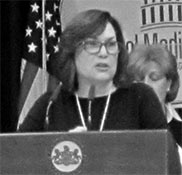 Dr. Nancy Falvo, board secretary |
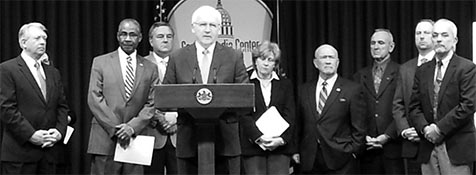 Left to right: Sen. John Wozniak, board vice chairman; Dr. Livingston Alexander, board member; Taylor Doebler III, board member; Sen. Gene Yaw, board chairman; Sen. Judy Schwank; Dr. Ted Alter, board member; Rep. Sid Michaels Kavulich, board member; Steve Brame, board member; and Rep. Garth Everett, board treasurer. |
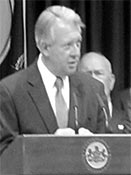 Sen. Wozniak |
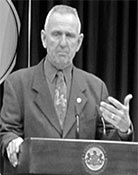 Rep. Kavulich |
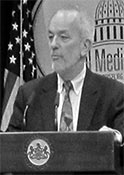 Rep. Everett |
Rural Snapshot: Pennsylvania Public School Teachers
A Note on the Analysis
For this Snapshot, the Center used data from the Pennsylvania Department of Education's 2014-15 Professional Personnel Individual Staff Report. The Center limited its analysis to full-time, active, classroom teachers who taught in a public school district. The total number of teachers in the Center's analysis (104,898) differs from the total number of teachers in the department's summary table (105,903). This difference is largely attributed to the exclusion of teachers who were not active (teachers on sabbatical, suspension, or workers compensation) in the Center's analysis. The difference of 1,008 classroom teachers is spread across 202 school districts; 56 percent of which had a discrepancy of two or fewer teachers. Additionally, when teachers were assigned to more than one category, such as music, English, and math, the Center only counted them once for the number of years teaching, educational attainment, gender, and annual salary. This filter was removed when analyzing teacher assignments. Finally, there were no data for the Bryn Athyn School District.
Rural and Urban Classroom Teachers by Gender, 2014-15
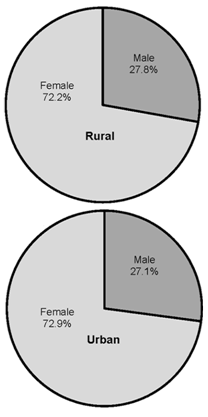
Highest Level of Educational Attainment, 2014-15
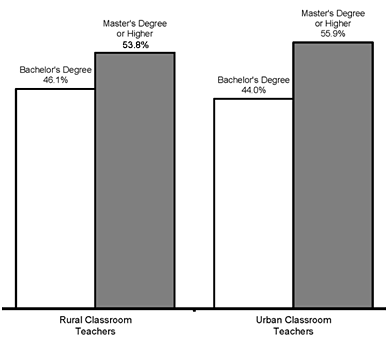
Classroom Teachers by Grade and Gender, 2014-15
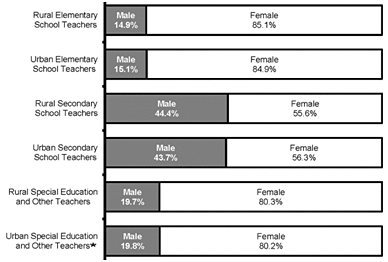
Rural and Urban Classroom Teacher Median Annual Salary by Gender, Educational Attainment, and Years Teaching in Current School District, 2014-15
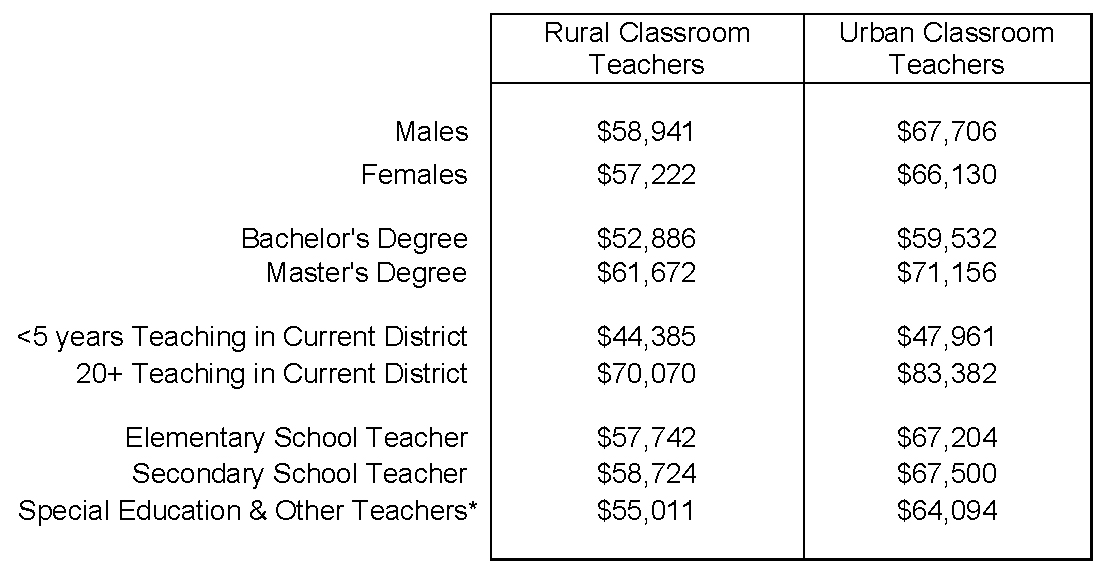
Classroom Teachers by Number of Years in Education, 2014-15
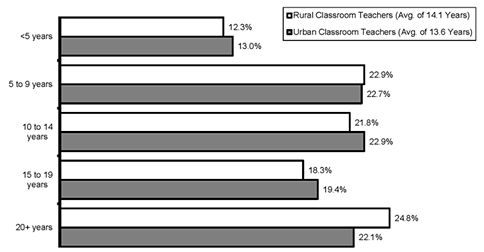
Teaching Assignments in Rural and Urban School Districts, 2014-15
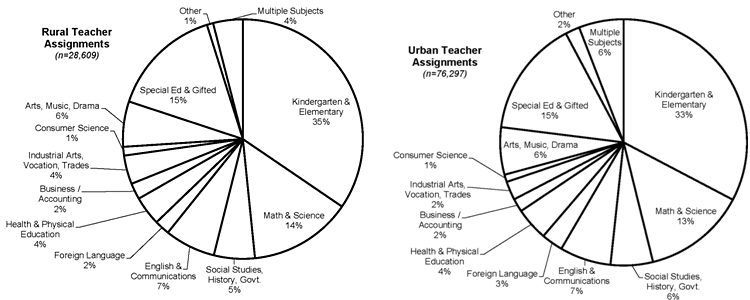
Report Details Economic Impact of PA Heritage Areas
Heritage tourism is an important segment of Pennsylvania’s overall tourism economy, supporting significant numbers of businesses and jobs. According to research sponsored by the Center for Rural Pennsylvania and Heritage PA and conducted by Dr. John M. McGrath of the University of Pittsburgh at Johnstown and his team of researchers, tourists spent an estimated 7.5 million days/nights in Pennsylvania’s 12 Heritage Areas in 2014, purchasing $2 billion worth of goods and services. The total contribution of heritage visitor spending, including direct, indirect and induced effects, to the state’s economy was 25,708 jobs and $798 million in labor income.
The research, conducted in 2014-2015, studied five Pennsylvania Heritage Areas: PA Route 6, National Road, Allegheny Ridge, Lincoln Highway, and Susquehanna Gateway. The research involved a survey of heritage-area visitors, interviews with stakeholders in the five study heritage areas (HAs), and an estimation of the economic impact of the heritage-related visitation to all 12 HAs statewide.
The research found that the five study HAs contribute positive economic benefits to their local geographic regions by facilitating economic development projects and bringing visitors. Results from the visitor surveys also found that approximately 70 percent of visitor spending and associated economic effects would be lost to these regions if heritage anchor attractions were not available. The importance of these individual attractions was underlined by one finding that indicated low awareness of the concept of a “heritage area” as well as the existence of the overall HA Program.
Based on the research findings, the research team recommended several actions to improve aspects of the HA Program including a meeting between HA staff and key Department of Conservation and Natural Resources (DCNR) leaders to develop a statewide roadmap for the future of the HA Program. For a copy of the research results, The Economic Impact of Pennsylvania Heritage Areas, visit www.rural.palegislature.us.
Adult Obesity Rates Increase in Pennsylvania and U.S.
According to the most current estimates from the Centers for Disease Control and Prevention (CDC) from 2012, nearly one out of three (32 percent) rural Pennsylvania adults is obese. Since 2004, the number of rural adults who are obese increased 23 percent.
Among urban adults, the CDC estimates 28 percent are obese. From 2004 to 2012, the number of urban adults who are obese also increased 23 percent.
The CDC’s identifies obese adults as those individuals 20 years old and older with a body mass index of 30 or greater. The data for the CDC estimates were derived from individuals who self-reported their height and weight.
In rural Pennsylvania, males were more likely to be obese (33 percent) than females (31 percent). In urban Pennsylvania, the obesity rate among males and females was identical (28 percent).
Nationwide, 27 percent of adults were estimated to be obese. From 2004 to 2012, the number of adults who were obese increased 29 percent.
In 2012, the states with the highest obesity rates were Mississippi, Louisiana and West Virginia, each with a rate above 33 percent. The states with the lowest rates were California, Hawaii and Colorado, each with a rate below 23 percent. Among all 50 states, Pennsylvania had the nation’s 23rd highest obesity rate.
Pennsylvania counties with the highest adult obesity rates were Fayette, Indiana and Carbon, each with a rate above 35 percent. The counties with the lowest rates were Delaware, Montgomery and Chester, each with a rate of 26 percent or lower.
Percent of Rural and Urban Adults (20+) Who Are Obese, 2004 to 2012
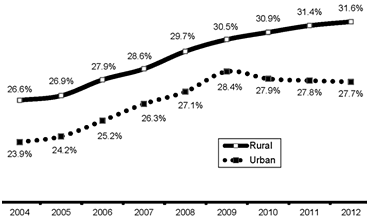
Just the Facts: One Plus One
In 2013, 51 percent of the 3.3 million adults in rural Pennsylvania were married and living with their spouse, according to U.S. Census Bureau data. An adult is someone age 18 years or older. Of the 6.7 million adults in urban Pennsylvania, 46 percent were married and living with their spouse.
According to the 2013 American Community Survey, Public Use Microdata Sample (ACS-PUMS), 78 percent of currently married adults in rural Pennsylvania have been married once, and 22 percent have been married two or more times. Among currently married adults in urban Pennsylvania, 81 percent have been married only once, and 19 percent have been married two or more times.
On average, rural married couples have been married longer (26 years) than urban couples (24 years).
Rural couples also tend to get married at younger ages than urban couples. For example, among the rural couples who have been married only once, the male was 26 years old and the female was 24 years old when they married. Among urban couples who have been married only once, the male was 27 years old and the female was 25 when they married. (Note: This analysis excluded same-sex couples because of the very small sample size.)
Since the 1950s, the average age of individuals at the time of their marriage has increased. In 1950, rural males were 22 years old and rural females were 20 years old, on average, when they married for the first time. In 2013, rural males were 31.2 years old and rural females were 30.6 years old, on average, when they married for the first time.
Among rural couples who have been two or more times, the male’s age, on average, was 40 years old and the female’s was 37 years old when they last remarried. Among urban couples, the male was 40 years old and the female was 38 years old, on average, when they last remarried.
In both rural and urban areas, there is an average 3.5 year age gap between spouses. In 65 percent of these marriages, the male is older by 4 years, and in 21 percent of these marriages the female is older by 3 years. In 14 percent of these marriages, both spouses are the same age.
